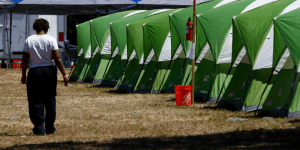COVID-19 and the homeless: How cities can turn temporary measures into permanent gains

During the COVID-19 crisis, city leaders have been moving faster than ever before to protect residents experiencing homelessness.
They’ve converted vacant hotels, unused recreation centers, and empty convention halls into shelter spaces fit for social distancing. Cities such as Los Angeles and London have committed, in ways that would have seemed impossible just two months ago, to bring vulnerable people living on the street inside in some way. Others are stepping up their outreach to those living on the street by delivering facemasks, providing meals and handwashing stations, and encouraging “safe camping.”
There was good reason for cities to act fast: The homeless are among the most vulnerable populations when it comes to COVID-19, and are at high risk of not only contracting it themselves but also spreading it to others.
Now, it’s time for city leaders to turn these emergency measures into long-term strategies and make a giant leap forward in how we handle homelessness in the United States. To do that, cities will need to be creative about how they use federal recovery dollars, and seek silver-lining opportunities in the decline of the hotel industry to create new permanent supportive housing. And above all, they’ll need to keep up the surge of innovative thinking that has powered the first two months of response.
How to do all of this will be the topic of a three-part webinar series offered by Bloomberg Philanthropies and beginning this Wednesday, May 20, at 1 p.m. EDT. All mayors and their key staff on homeless response are invited to attend. They’ll hear from operational leaders in the field from cities across the U.S. and around the world, and frame out a vision for what the best mid-term and permanent responses to homelessness can look like in the COVID-19 era. You can register to attend the webinars here.
Ahead of these sessions, here are six things cities should consider as they look to leverage the current crisis to improve outcomes for the homeless in the long run:
1. Adjust time horizons. While the initial stages of the emergency response are behind us, public-health leaders are clear that coronavirus concerns are not going away anytime soon. That means cities will need to continue to be vigilant in support of high-risk homeless populations for the foreseeable future. If you started out with a 60-to-90 day response timeframe, it’s time to adjust your horizon to the next 12 to 24 months.
[Get the City Hall Coronavirus Daily Update. Subscribe here.]
2. Have a plan for testing. As testing capacity becomes more available, cities must prepare to implement testing and contact tracing in homeless shelters and on the street, and they must have a plan in place for how to deal with isolated positive cases or potential outbreaks. Even when beds are spaced six feet apart, the virus can spread quickly in shelters. When that happens, it not only endangers the health of clients and staff but also creates a rapid need for new beds where infected people can isolate. To avoid that outcome, cities need to either proactively bring testing to the homeless or provide them safe transport to testing locations. A clear testing protocol should be developed ahead of time, which will involve negotiation between social service agencies, private service providers and local health authorities to balance the need to separate them from others with the complex challenges of individuals experiencing homelessness.
3. Rethink life on the streets. For those who have remained on the streets through the pandemic, new strategies have emerged to meet their needs, keep them safe, and leverage moments to bring them inside. The closing of the New York City subways during overnight hours created the imperative to provide people discharged at end-point terminals with outreach and placement services; this has managed to get hundreds of people to a bed in just the first week. San Francisco’s strategy of sanctioning some safe outdoor encampments brings stability to residents, meets their basic needs, and increases the chance they will get connected to services. Let this moment help us uncover the solutions that are there, which we have failed to acknowledge in the past.
4. Start thinking about permanency. As the crisis continues, temporary shelter spaces will need to become longer-term arrangements. Shelters set up on-the-fly in temporarily closed buildings may need to move as cities slowly begin reopening; meanwhile, cities that signed short leases with hotels will need to extend them. Considering these measures will continue beyond the emergent 90 days, let’s acknowledge we should be working with every person to secure a place to live. Dollars spent on high-cost and temporary sheltering can be converted to permanent housing pathways. Get creative with relief funds to explore how they might be used to secure housing through rental assistance and pay for capital conversions of hotels into supportive housing, rather than paying for shelter for a long duration.
[Read: 5 ways cities are tackling homelessness in a time of COVID-19]
5. Prevent a new surge in homelessness. Many cities and states have passed short-term moratoriums on evictions, or have enhanced financial support for people with low incomes who have lost their jobs. When these expire, measures directed to these vulnerable households need to be put in place to prevent them from becoming the next wave of people suffering from homelessness. Outreach and flexible support in meeting household needs should be designed to avoid loss of housing in these high-risk situations.
6. Protect victims of domestic abuse. We have seen spikes in reports of domestic violence across cities. Reports of child abuse are down, but no one doubts the reality that there are many children experiencing abuse who are unable to reach out for help themselves. We have to feel confident that these safety issues are being pursued aggressively and that we have resources to keep victims safe. This may include immediate access to shelter if the victim cannot be kept safe at home, and strategies to return them safely or create a path to a new home.
Cities are moving fast and iterating solutions to protect and serve the homeless. Excavating these strategies for permanent solutions will transform systems and improve the lives of countless vulnerable members of our communities.
Gibbs in a Principal at Bloomberg Associates and a former New York City Deputy Mayor for Health and Human Services.
Register here for the Cities Addressing Homelessness webinars. They will be held three consecutive Wednesdays at 1 p.m. EDT, starting May 20.


